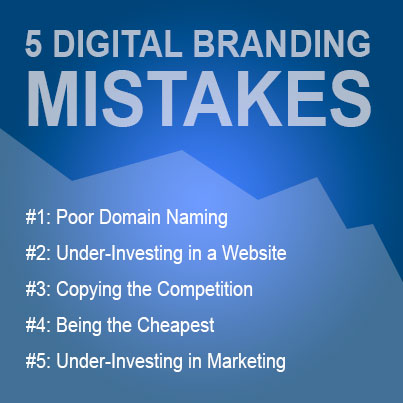
Maybe you heard it from a college buddy or read it somewhere online. We often take advice from friends and colleagues on products to buy, books to read, cars to drive, movies to watch and more. There is no doubt, friends can be very helpful in making purchase decisions big and small.
When it comes to growing your business, do you lean on the same advice from those same friends? If the answer is yes, take a moment to consider their background. Someone who is a great chef or successful banker is a master of their craft. They have spent many years fine tuning their talents. Those years of hard work have paid off in making them who they are today. Does their expertise in cooking or corporate finance also make them an expert in digital marketing? Most likely no.
Avoid These 5 Digital Branding Mistakes
What works for one business or industry does not work for all. There is no secret sauce that all businesses must tap into for success. Below are five common mistakes companies make when trying to market their business online.
1. Poor Domain Name Branding
Did a buddy, or worse yet a black hat SEO, tell you that “Cheapiphonecase.com” was a great domain name for your company? Domain names stuffed with keywords are more likely to be flagged for Google spam in 2014. What may have been a strength in 2008 is now a liability.
Have a domain name that fits your brand. If your company name is “Pete’s Home Electronics”, stick with that name and branding for your domain name. Better yet, if you can shorten that name to something easy to remember and share, go for it. Long domain names and keyword filled domains have a very tough row to hoe.
Poor: Cheapiphonecase.com
Good: Peteselectronics.com
2. Under-Investing in a Website
How can you tell the story about your brand with a logo, text and few links to white papers? Under-investing in a website can give a poor reflection of your actual services. If you want to be viewed as “best in class”, have a “best in class” web presence. Just because your friend paid $599 for a website for his pizza shop doesn’t mean your high profile law firm should do the same. Have a website budget that matches your industry. Higher paying customers expect you to have a high quality website.
Ignore the competition and stand out! Which leads me to my next point…
3. Copying the Competition
Competitive analysis is an important part of monitoring your industry. Competitors can provide insights into strategies and tactics. Your gut instinct may be to find that top competitor and copy everything they’re doing to be successful. The problem with being a copy of your competitor is just that. You’re a copy, not original or special in any way. If you copy most or all of what your top competitor does in marketing, you will be seen as “the same” or inferior if you are trying to under-cut your competitors on price. Find something that makes you stand out.
4. Be the Cheapest (and the Best)
Pricing is an important part of branding your product or company. Do you want customers to see you as “the cheapest” or “the best”? “The cheapest” and “the best” are usually not the same company or product. Think about how you want to position your product in the minds of customers. Apple products, for example, are not the cheapest. Apple does however rate high on product satisfaction. Being the cheapest means being the cheapest always. If customers expect to you to be cheapest, they will expect you to always lower your prices even if it means cutting your margins down to nothing. Provide value and you will get valuable customers in return.
5. Under-Investing in Marketing
You are a small business or startup. To see a return on your marketing investment is going to take time. It’s not going to happen in a few weeks or even a few months. The smaller your budget, the longer it will generally take to see results from your efforts. For example, your top competitor is spending $15,000 per month in Google AdWords. How much business do you think $500 per month is going to bring? Be realistic with your marketing budget and make sure your budget matches your expectations.
Having all your digital budget in one bucket is also a bad strategy. If there is a major disruption to one channel (like Google Panda) your business is going to feel the negative impact of that change more than competitors. Have a multi-channel strategy to make sure your marketing is sustainable for years to come.
